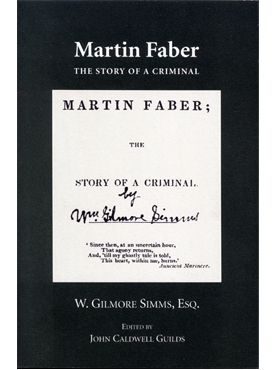William Gilmore Simms’s (1806–1870) body of work, a sweeping fictional portrait of the colonial and antebellum South in all its regional diversity, with its literary and intellectual issues, is probably more comprehensive than any other nineteenth-century southern author. Simms’s career began with a short novel, Martin Faber, published in 1833.
This Gothic tale is reminiscent of James Hogg’s Confessions of a Sinner and was written four years before Edgar Allan Poe’s “William Wilson.” Narrated in the first person, it is considered a pioneering examination of criminal psychology. Martin seduces then murders Emily so that he might marry another woman, Constance. Martin confesses to his friend and is killed after attempting to stab Constance when she visits him in jail.
The book was immediately successful and was well received by the northern media, thus starting Simms’s successful career as a writer, one that would rank him as the only major southern literary figure besides Poe before the Civil War. As with other volumes in the Arkansas Edition of Simms’s work, this volume includes a critical introduction by the editor and a Simms chronology, as well as appendices dealing with textual matters. This edition also includes Simms’s 1829 story, “Confessions of a Murderer,” which was the germ for his first book of fiction.
“All students of Southern literature owe a huge debt to Jack Guilds and the University of Arkansas Press for providing us with the elegant and useful new editions of the work of William Gilmore Simms. Martin Faber is a splendid addition to the increasingly-available body of Simms’s work.”
—Noel Polk, editor, The Mississippi Quarterly

